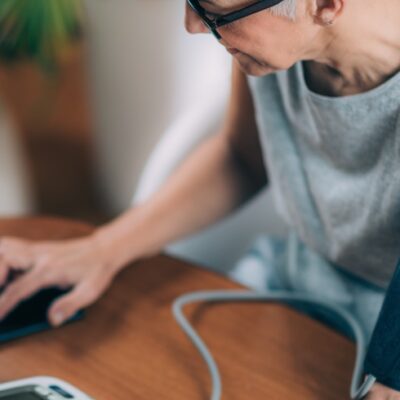The top four remote patient monitoring (RPM) devices are the:
- Blood Pressure Cuff
- Blood Glucose Monitor
- Digital Weight Scale
- Pulse Oximeter
These RPM devices track and monitor a variety of chronic conditions to help Medicare patients receive personalized care from the comfort of their home. With integrated cellular devices, patient data is automatically transmitted to doctors without any patient intervention, monthly plans, or bills. RPM companies like 100Plus offer the most accurate and easiest to use remote monitoring devices for your at-risk Medicare patients.
Blood Pressure Cuff
Blood pressure cuffs are used to measure patient blood pressure and can be self administered easily at home. For the most accurate readings, patients are advised to use blood pressure cuff best practices while taking measurements. 100Plus provides a device, which automatically transmits readings to providers, and is the fastest and most accurate tool for monitoring and the best at-home measuring technique.
Blood pressure cuffs are best used for tracking:
Hypertension
Hypertension monitoring is crucial in early detection of high blood pressure (HBP). HBP is often symptomless and can go undetected in patients for long periods between in person visits. Monitoring blood pressure daily can help to prevent emergencies that often occur with undiagnosed hypertension, allows practitioners to take early action, and is proven to lower patient blood pressure.
Monitoring the Treatment of Hypertension
Treatment of high blood pressure varies from preventative daily blood pressure monitoring in that it applies to patients who have started receiving treatment for diagnosed hypertension. Monitoring the treatment of hypertension allows practitioners to determine the efficacy of the medication between visits. If treatment is not as effective as desired, an adjustment in dosage may be required. If treatment does not appear to be effective at all, the patient is at risk of a stroke or a heart attack and action should be taken to remedy the situation. Monitoring treatment for hypertension allows practitioners to make more informed decisions in the process of managing their patients’ high blood pressure and is proven to lower patient blood pressure.
White Coat Syndrome
Another patient application of at-home blood pressure monitoring is something called White Coat Syndrome, also known as White Coat Hypertension. This is when patients exhibit higher than normal blood pressure when visiting doctors offices. An increase in blood pressure is common during stressful situations and is often caused by anxiety, a feeling many patients experience during an office visit. When patients are able to measure their blood pressure daily, in the comfort of their home, practitioners are less likely to receive faulty measurements due to White Coat Syndrome.
Blood Glucose Monitor
For patients who need to monitor their glucose on a daily basis, the blood glucose monitor is fast and easy to use. With daily data recorded, practitioners are able to make more informed decisions based on patterns and trends in their patients glucose levels. If patient measurements indicate that their levels are out of safe range or that the patient requires intervention, the remote blood glucose monitor will alert the appropriate staff members.
Just a single drop of blood allows physicians to track:
- The effect of new medication
- The effects of various diets or exercise regimens
- Progress and success in treatment plans
- When it’s time to intervene or schedule a visit
Blood glucose monitors are most commonly used when managing and treating:
Diabetes Type 1
The best way to manage type 1 diabetes is with regular blood glucose readings which can be easily self administered in patients’ own homes. To make measuring glucose as simple as possible, some RPM devices, such as the blood glucose monitor from 100Plus, transmit patient readings directly to practitioners with no user intervention.
Diabetes Type 2
This form of diabetes, type 2, also requires close monitoring and control. Without daily readings, type 2 patients can become at risk for a variety of diabetes related complications, such as kidney or nerve damage, that can develop in the time between doctors visits. Research has shown that RPM and telehealth are effective in managing HbA1c levels in patients living with type 2 diabetes. Blood glucose monitors help patients who have developed type 2 diabetes and enable practitioners to proactively approach their treatment plans.
Digital Weight Scale
The digital weight scale allows patients to weigh themselves daily and enables practitioners to track minute changes in patient data and predict potential health events.
The digital weight scale can be applied to:
Congestive Heart Failure
Keeping track of weight is especially important for patients suffering from congestive heart failure (CHF). Gaining as little as 2-3 pounds can indicate that a CHF patient is at risk and the increase in weight may signify a change in water retention.
Obesity
Remote digital scales allow for practitioners to monitor their patients daily during their weight management plans. These plans should extend beyond the sporadic weigh-ins that occur in office. Tracking progress in obese patients enables patients and their practitioners to establish trends and patterns in order to achieve success in their weight management.
Weight Fluctuations
Remote daily weight management also allows practitioners to monitor weight fluctuations that occur outside of regularly scheduled visits. Tracking patient weight may be crucial not only in finding the root cause of an issue, but in ensuring that patients remain in a safe range.
Pulse Oximeter
Pulse oximeters are a non-invasive remote monitoring tool that records pulse as well as the blood oxygen levels of patients. Taking these readings daily assists practitioners by giving them a better overview of patients health and wellbeing.
Pulse oximeters are particularly helpful in identifying and managing:
COVID-19
Catching symptoms early is key in the treatment of COVID-19, especially for senior patients and those who are more likely to be at higher risk of hospitalization. Low blood oxygen levels are a key indicator. Anytime a patient’s blood oxygen level is below normal range the appropriate staff will be notified so that action can be taken. RPM can also reduce COVID-19 hospital readmissions.
Asthma
Low blood oxygen levels can also be a symptom of asthma as those who suffer from the condition often have difficulty breathing and consequently lower blood oxygen levels. Pulse oximeters are a great way to not only track patient progress, but also assess the efficacy of medication and treatment.
Pneumonia
Pneumonia also makes breathing difficult and can therefore decrease blood oxygen levels. This viral, bacterial, or fungal infection of one or both of the lungs may require treatments such as oxygen therapy. The need for such a treatment can be determined through assessing daily recorded patient data using a remote pulse oximeter that automatically uploads patient data to practitioners.
Chronic Obstructive Pulmonary Disease (COPD)
Difficulty breathing is a symptom of COPD. Not only can pulse oximeters monitor the status, treatment, and progress of patients, but remote tools are proven to reduce the acute care needed for patients with COPD.



